Science of the Total Environment ( IF 8.2 ) Pub Date : 2020-11-23 , DOI: 10.1016/j.scitotenv.2020.143921 G.M. Lanzafame , D. Srivastava , O. Favez , B.A.M. Bandowe , P. Shahpoury , G. Lammel , N. Bonnaire , L.Y. Alleman , F. Couvidat , B. Bessagnet , A. Albinet

|
Twenty-five biogenic and anthropogenic secondary organic aerosol (SOA) markers have been measured over a one-year period in both gaseous and PM10 phases in the Paris region (France). Seasonal and chemical patterns were similar to those previously observed in Europe, but significantly different from the ones observed in America and Asia due to dissimilarities in source precursor emissions. Nitroaromatic compounds showed higher concentrations in winter due to larger emissions of their precursors originating from biomass combustion used for residential heating purposes. Among the biogenic markers, only isoprene SOA marker concentrations increased in summer while pinene SOA markers did not display any clear seasonal trend. The measured SOA markers, usually considered as semi-volatiles, were mainly associated to the particulate phase, except for the nitrophenols and nitroguaiacols, and their gas/particle partitioning (GPP) showed a low temperature and OM concentrations dependency. An evaluation of their GPP with thermodynamic model predictions suggested that apart from equilibrium partitioning between organic phase and air, the GPP of the markers is affected by processes suppressing volatility from a mixed organic and inorganic phase, such as enhanced dissolution in aerosol aqueous phase and non-equilibrium conditions. SOA marker concentrations were used to apportion secondary organic carbon (SOC) sources applying both, an improved version of the SOA-tracer method and positive matrix factorization (PMF) Total SOC estimations agreed very well between both models, except in summer and during a highly processed Springtime PM pollution event in which systematic underestimation by the SOA tracer method was evidenced. As a first approach, the SOA-tracer method could provide a reliable estimation of the average SOC concentrations, but it is limited due to the lack of markers for aged SOA together with missing SOA/SOC conversion fractions for several sources.
中文翻译:

巴黎地区(法国)的次级有机气溶胶(SOA)标记物的一年测量:浓度,气体/颗粒分配和SOA源分配
在一年的时间内对气态和PM 10中的25种生物和人为产生的次级有机气溶胶(SOA)标记物进行了测量巴黎地区(法国)的各个阶段。季节性和化学模式与以前在欧洲观察到的相似,但由于源前体排放的差异,与美国和亚洲观察到的显着不同。硝基芳香族化合物在冬季显示出较高的浓度,这是由于其用于住宅供暖目的的生物质燃烧产生的前体排放量较大。在生物标志物中,夏季仅异戊二烯SOA标志物浓度增加,而pin烯SOA标志物未显示任何明显的季节性趋势。测得的SOA标记物通常被认为是半挥发物,除了硝基酚和硝基愈创木酚以外,主要与颗粒相有关,并且它们的气体/颗粒分配(GPP)显示出低温和OM浓度依赖性。用热力学模型预测对其GPP进行的评估表明,除了有机相和空气之间的平衡分配外,标记的GPP还受到抑制有机和无机混合相挥发性的过程的影响,例如在气溶胶水相和非水相中的溶解度提高。平衡条件。SOA标记物浓度被用于分配二次有机碳(SOC)来源,同时应用了改进版的SOA-示踪剂方法和正矩阵因式分解(PMF)。两个模型之间的总SOC估算值非常吻合,除了夏季和高温期间。处理的春季PM污染事件,其中SOA示踪剂方法系统地低估了证据。作为第一种方法,SOA示踪剂方法可以提供平均SOC浓度的可靠估计,











































 京公网安备 11010802027423号
京公网安备 11010802027423号